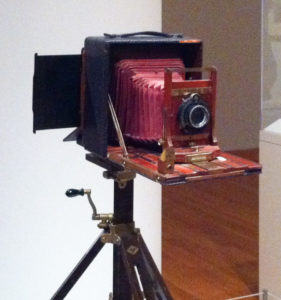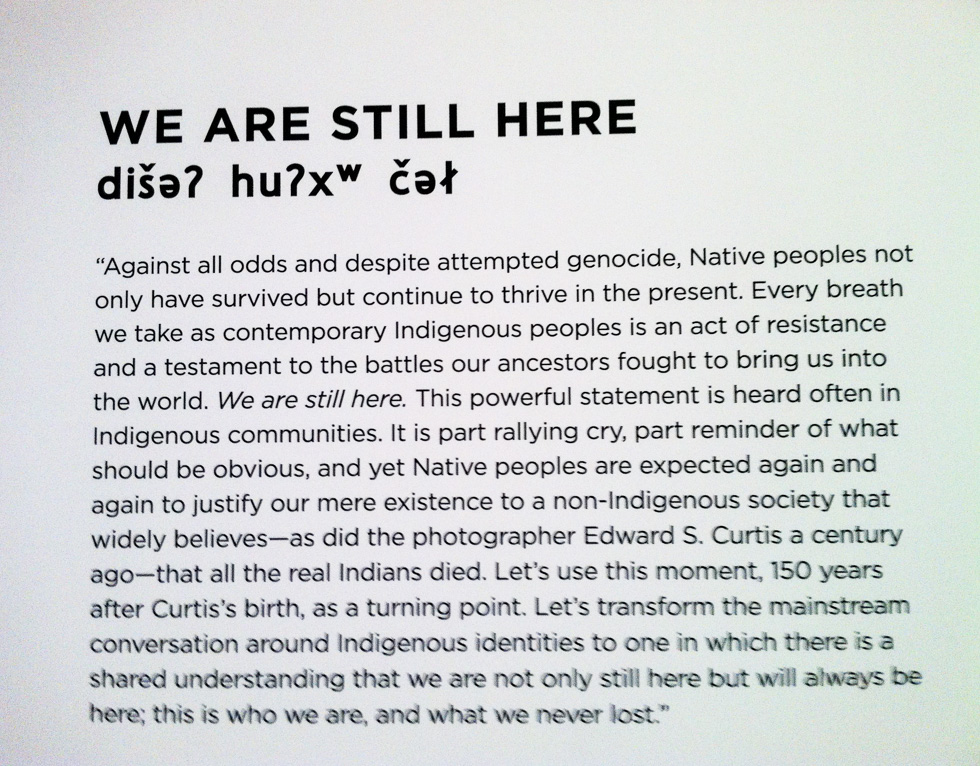 Ever wondered what the camera looked like that Edward Curtis used to take thousands of photos of Native Americans during the late 19th/early 20th century? Here it is/was, on display at the recent Seattle Art Museum exhibit “Double Exposure”. Not your simple “put in your pocket iPhone” that allows you to hike over precarious terrain and easily capture images without much of a thought. It’s a wonder that he was able to accomplish all that he did with this enormous and heavy piece of equipment that he had to carry over challenging landscapes where there were no roads, along with heavy glass plates–no film or SD cards to capture the image back then.
Ever wondered what the camera looked like that Edward Curtis used to take thousands of photos of Native Americans during the late 19th/early 20th century? Here it is/was, on display at the recent Seattle Art Museum exhibit “Double Exposure”. Not your simple “put in your pocket iPhone” that allows you to hike over precarious terrain and easily capture images without much of a thought. It’s a wonder that he was able to accomplish all that he did with this enormous and heavy piece of equipment that he had to carry over challenging landscapes where there were no roads, along with heavy glass plates–no film or SD cards to capture the image back then.
The SAM exhibit displayed hundreds of his images of Native Americans that were iconic, beautiful, and unique in that there isn’t much of a record of early Native Americans aside from the work of Curtis. However, controversy abounds concerning his photography because of the limited perspective his vision brought to the American population. At the same time his beautiful images were created, Native Americans were being killed, familes were being torn apart to force children into boarding schools, their religious practices were banned, their land was taken away from them, and treaties weren’t being honored. None of this was documented by Edward Curtis, although it seems his aim was to capture what he thought was a ‘dying race’.
 The result of the work of Edward Curtis is that we see Native Americans through his eyes, the images he created. SAM’s exhibit “Double Exposure” included a side of the story that was never told—Native Americans through their ‘own eyes’, allowing them to define who they are. One of the docents who gave a tour who was Native American only commented on the current NA artists’ work and the one Curtis photo that disturbed her more than others, although all of the photos by Curtis made her angry. Instead of only admiring the beautiful work by Curtis and appreciating the harmonious and resourceful life of Native Americans, I left the exhibit somehwat disturbed as well. One of the text pieces on the wall is a good way to conclude: “We are STill Here…”
The result of the work of Edward Curtis is that we see Native Americans through his eyes, the images he created. SAM’s exhibit “Double Exposure” included a side of the story that was never told—Native Americans through their ‘own eyes’, allowing them to define who they are. One of the docents who gave a tour who was Native American only commented on the current NA artists’ work and the one Curtis photo that disturbed her more than others, although all of the photos by Curtis made her angry. Instead of only admiring the beautiful work by Curtis and appreciating the harmonious and resourceful life of Native Americans, I left the exhibit somehwat disturbed as well. One of the text pieces on the wall is a good way to conclude: “We are STill Here…”
Note: to see some of the iconic images by Curtis and the current Native American artists, click here.

2 Comments
Thank you for this lovely post about the exhibit! I wish I could have seen it. It sounds very moving. Glad I got to see a little of it through your eyes.
Thank you for your comment! It was a very comprehensive exhibit of great work and it underscored the enormity of the ambition and accomplishments of Edward Curtis. And it also showed what was ‘left out’ in his telling of the story of Native Americans: their own voices and the decimation of their culture (BUT, they are still here). For anyone unable to see the exhibit, a book that provides interesting background to these images and Edward Curtis is “Short Nights of the Shadow Catcher: The Epic Life and Immortal Photographs of Edward Curtis” by Timothy Egan.